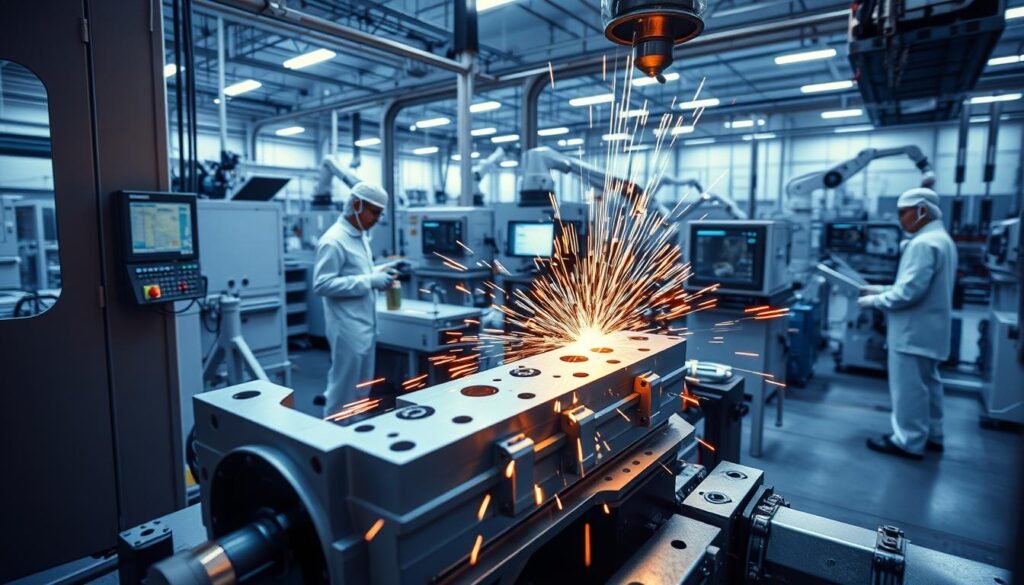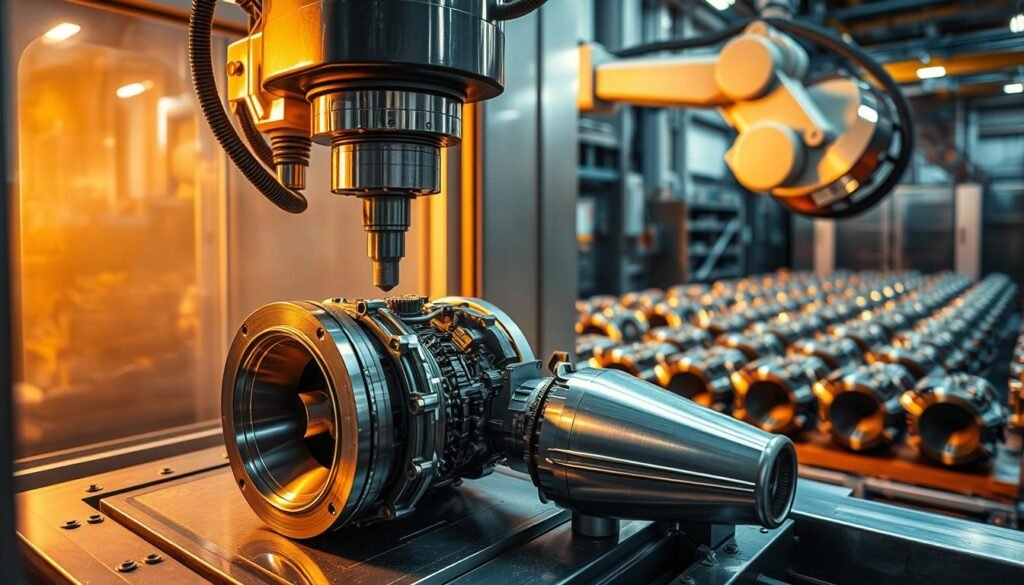Les industrie aérospatiale needs Usinage CNC for its unmatched precision and speed. It makes top-notch aerospace parts. Accuracy is key in making planes and spaceships, where small mistakes can be big problems.
Usinage CNC meets high standards and follows strict rules. This is vital for keeping aerospace parts safe and reliable. It also cuts down on mistakes made by people, making everything safer.
Merci à Usinage CNC, aerospace can keep getting better. It helps make new, better parts for planes and spaceships. This is how we keep moving forward in aerospace.
Principaux enseignements
- CNC machining provides precision vital for fabrication aérospatiale.
- Haute qualité composants aérospatiaux rely on advanced machining technologies.
- Stringent normes de qualité and regulations enhance part reliability.
- Automation reduces human error in critical manufacturing processes.
- Advancements in CNC technologies drive innovation in aerospace performance.
The Importance of Precision in Aerospace Manufacturing
In aerospace, precision is key, not just a goal. Small changes in parts can affect how well an aircraft flies and its safety. This field follows strict quality rules to make parts that can handle tough conditions.
Quality Standards in Aerospace Parts
Following standards like AS9100 is crucial in aerospace. These rules make sure parts are safe and work well. So, parts are made with very tight limits, like 4 microns, for things like jet engines.
This focus on quality means parts are reliable and can handle flight demands.
Impact of Tolerances on Safety
Getting tolerances right is very important in aerospace. Small mistakes can cause big problems. We work hard to make parts with tolérances serrées to avoid failures.
Our process uses advanced CNC machines. These methods make us more efficient and show our commitment to quality. For more on our CNC machining, check out Mekalite’s CNC machining solutions.
Usinage CNC pour l'aérospatiale

CNC machining is key in the aerospace world. It offers the precision and speed needed for making vital aerospace parts. It uses advanced tech to make parts for planes and spaceships.
Defining CNC Machining
CNC machining uses computers to control machines. It shapes and cuts materials with great precision. This method cuts down on mistakes and boosts quality.
It’s perfect for making aerospace parts that need to be just right. This is because it can follow strict rules and standards.
Applications of CNC Machining in Aerospace
CNC machining has many uses in aerospace. Some of these include:
- Building parts like fuselage frames and wings.
- Creating shapes that help planes fly better.
- Making parts from special materials like strong alloys and plastics.
- Offering custom parts for specific needs.
This tech makes planes and spaceships better. It helps solve the challenges of making things more complex. It leads to new ideas in engineering.
The Role of 5-Axis CNC Machining

Usinage CNC à 5 axes has changed how we make things in the aerospace world. It lets us move in five directions at once. This makes it easier to make complex shapes and special parts.
Benefits of 5-Axis Machining Technology
Usinage CNC à 5 axes has many benefits. It makes making things faster and more precise. Here’s why:
- Temps de préparation réduit : We need fewer setups, so we can make things quicker.
- Increased Precision: It cuts and shapes better, giving us the best results.
- Enhanced Flexibility: It can handle more designs and needs.
Complex Geometries and Lightweight Designs
There’s a big need for light parts in aerospace. Usinage CNC à 5 axes meets this need. It makes parts that are strong but light. Here’s what it offers:
- Hollow Structures: It can make parts with holes, which makes them lighter.
- Design Alternatives: It lets us try new designs that are both strong and light.
- Improved Performance: Light parts make the whole plane more efficient and better.
Advantages of Using CNC Machining Processes

Les industrie aérospatiale now uses CNC machining more. This technology helps a lot. It makes production better and solves big problems.
It helps make parts without mistakes. This makes production smooth and consistent. CNC machining is key to doing things right.
Minimizing Part Errors
CNC machining uses new tech to cut down on mistakes. It’s very precise and does things the same way every time. This means fewer bad parts.
It’s very important for safety in aerospace. Automation helps by reducing mistakes made by people. It also lets for better checks on quality.
- High precision in machining operations
- Automated quality checks that enhance reliability
- Real-time monitoring of machining conditions
Enhancing Consistency and Efficiency
CNC machining also makes production more consistent. It’s great for making one part or many. Quality stays the same, which is very important.
This tech makes making things faster and cheaper. It helps a lot in aerospace. Here’s how:
- Reduction in setup times and operational costs
- Improved cycle times facilitating quicker turnaround
- Consistent output that meets or exceeds industry standards
Materials Used in Aerospace CNC Machining
Choisir le bon materials for aerospace machining is key. We mainly use alliages d'aluminium et composants en titane. They have great properties for aerospace needs. Engineering plastics also help reduce weight and improve performance.
Metals: Aluminum and Titanium
Alliages d'aluminium, like 7075, are chosen for their strength and lightness. This means we can save weight without losing strength. Titanium components are great for extreme conditions because they are strong and resistant to corrosion. They are used in jet engines and airframe structures.
Engineering Plastics and Their Significance
Engineering plastics, such as PEEK and polycarbonate, are becoming more popular. They help reduce weight and keep structures strong. These plastics are used in important parts to meet performance standards and ensure safety.
Machining Processes in Aerospace Manufacturing

Nombreux Procédés d'usinage CNC are key in aerospace making. Each one is made for specific needs, ensuring parts are precise and reliable. We look at Fraisage CNC, Tournage CNCet Perçage CNC, all important for aerospace.
Overview of CNC Milling and Turning
Fraisage CNC uses tools that rotate to make complex shapes. These shapes are crucial for parts like airframes and engine mounts. It’s great for making detailed shapes with tight fits, important in aerospace.
Tournage CNC makes round parts like shafts. It uses fast rotation and precise tools for a smooth finish. This is key for parts that need to work well in aerospace.
Importance of CNC Drilling in Component Fabrication
Perçage CNC is vital for making aerospace parts. It makes the exact holes needed for fasteners and hydraulic systems. The accuracy is crucial for safety and strength.
Our focus on quality in fabrication aérospatiale means we meet strict standards. For more on our services, check out Services d'usinage CNC.
| Processus d'usinage | Caractéristiques principales | Applications |
|---|---|---|
| Fraisage CNC | Rotating multi-point cutting tools; Creates géométries complexes | Airframes, engine mounts |
| Tournage CNC | High rotation speed; Exceptional surface finishes | Cylindrical parts (shafts) |
| Perçage CNC | Precise hole creation; Critical for fasteners | Structural components, hydraulic systems |
CNC Machining and Cost Efficiency
In the aerospace world, saving money is key. We use top-notch CNC machining to help. Automation cuts down on labor costs and boosts productivity. We also work hard to reduce material waste, which helps us make more money.
How Automation Reduces Labor Costs
Automation in CNC machining makes things more accurate and faster. This means we spend less on labor. Automated systems work with little human help, saving money and keeping quality high.
By using technology, we stay ahead. This shows how important automation is for saving money in aerospace machining.
Minimizing Material Waste for Better Profitability
We also focus on using less material. CNC machining lets us cut and shape materials with precision. This means less waste and lower costs for materials.
By reducing waste, we help the environment too. Our goal to save money fits with the aerospace industry’s push for sustainability.
Certifications in Aerospace Machining
In the aerospace world, following recognized certifications is key. It keeps quality high and meets rules. AS9100 and ITAR compliance are vital for our aerospace work.
Understanding AS9100 Certification
AS9100 sets a strong quality management system for aerospace. It’s based on ISO 9001 but adds aerospace needs. This ensures top-quality products from start to finish.
Getting AS9100 shows a company’s strong quality focus. It boosts their reputation and work efficiency.
Significance of ITAR Compliance
ITAR rules are key for defense item makers. They control tech exports and imports. This keeps sensitive info safe.
Following ITAR shows a company’s trustworthiness. It makes them stand out in aerospace.
Obtenir aerospace certifications like AS9100 and ITAR shows quality and safety. These are key for aerospace parts.
Conclusion
CNC machining is key for the aerospace world. It makes parts that are safe and work well. We all work hard to make sure these parts are top-notch.
The aerospace field is always changing. CNC machining will keep being important. We use new tech and focus on quality to help the industry grow.
We are leaders in making things with precision. To see how CNC machining helps in aerospace, check out this page on advanced manufacturing solutions.
FAQ
What is CNC machining and why is it important for the aerospace industry?
CNC machining is a digital process for making parts with high precision. It’s key for making aircraft parts reliable and safe. It ensures quality and reduces mistakes.
How does precision impact aerospace component manufacturing?
Precision is very important in aerospace. Parts need to be made with very small tolerances. CNC machining helps make parts that meet strict normes de qualité.
What are the primary applications of CNC machining in aerospace?
CNC machining is used for many aerospace parts. This includes structural parts and engine mounts. It’s great for making complex shapes needed in aerospace.
What advantages does 5-axis CNC machining offer?
5-axis CNC machining can move tools in five directions at once. This makes complex shapes easier to create. It also means parts can be made faster and lighter.
What are the benefits of using CNC machining processes in aerospace?
CNC machining is very precise and repeatable. This means fewer mistakes in parts. It’s great for making many parts or just a few, keeping quality high.
What materials are commonly used in aerospace CNC machining?
Strong yet light materials like aluminum and titanium are used. Also, plastics like PEEK are used for parts that need to be both strong and light.
How do CNC milling and turning differ in aerospace manufacturing?
CNC milling makes flat surfaces and complex shapes. CNC turning makes round parts that need to be precise and smooth.
How does automation in CNC machining contribute to cost efficiency?
Automation cuts down on labor costs and waste. This makes production faster and more profitable. It’s key for staying competitive in aerospace.
Why are industry certifications like AS9100 and ITAR compliance important?
These certifications ensure aerospace parts are made to high standards. AS9100 is for quality, and ITAR protects sensitive information.


